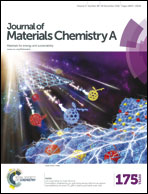Crystalline Cu-silicide stabilizes the performance of a high capacity Si-based Li-ion battery anode†
Abstract
Metal-silicides have demonstrated bright prospects as advanced anodes for lithium-ion batteries (LIBs). However, their roles in volume change accommodations are still unclear to us. Here, we design and fabricate a nanoporous Si/Cu0.83Si0.17/Cu composite, supported with a highly crystalline Cu-silicide/Cu rigid framework, which demonstrates a high reversible capacity of 820.4 mA h g−1 after 500 cycles at a current density of 3 A g−1. According to the in situ TEM, there was no obvious structural damage and electrode pulverization during the initial lithiation, and a highly crystalline LiCuSi phase was observed. Furthermore, the conversion of the Cu0.83Si0.17/LiCuSi couple during repeated cycles is highly reversible, and the structural integrity could be well maintained. These results demonstrate that the highly crystalline Cu-silicide together with the nanoporous structure contributes to the ultrastable cycle performance and the Cu-silicide/Cu rigid framework supported the superior rate performance. The present work points out a facile but effective strategy for the engineering of alloy type anodes with superior cycle and rate properties for next generation LIBs.



 Please wait while we load your content...
Please wait while we load your content...